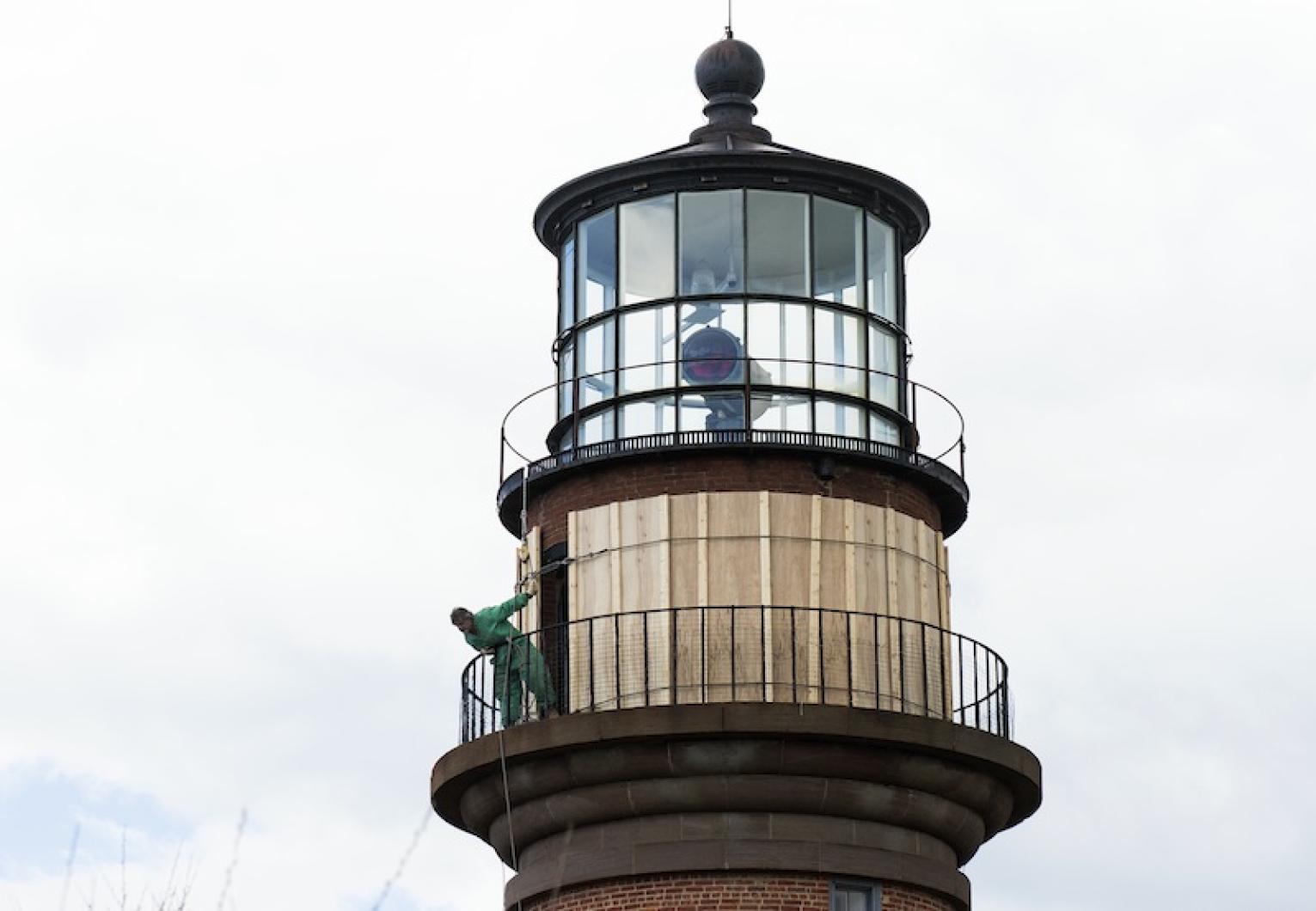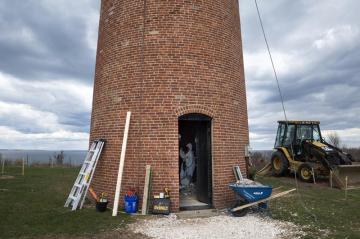
Worker secures brick tower Monday afternoon. Lighthouse wears wooden corset beneath the lantern. – Timothy Johnson
The Gay Head Light relocation project is under way.
On Monday morning, the sounds of brush cutters, chain saws and jackhammers came down from the small hill where the lighthouse stood beneath a darkening sky. Four companies were busily preparing the structure and its surroundings for the move, expected to begin in late May.
Workers from Landscope Inc. in Edgartown were clearing away brush and digging up shrubs and other plants from around the site. Much of the existing vegetation will be stored in a fenced-in area at the Aquinnah Circle and replanted after the move.
International Chimney Corporation, which will handle the move, was preparing the structure inside and out. Loose mortar already has been replaced, and on Saturday the second level of the lighthouse, just below the light room, was fitted with a wooden corset, held tightly by cables. Inside, a worker in a white jumpsuit was pounding away at a concrete block with a jackhammer.
“It’s exciting after two and a half years of planning and testing and everything to actually be making it happen,” said Len Butler, chairman of the lighthouse relocation committee, who was onsite Monday.
Many wooden stakes with colored ribbons marked the boundaries of the excavation, old foundations and other features. Larger stakes marked the new foundation, about 135 feet east of the lighthouse, and an observation well that will detect groundwater. The lighthouse stands just 46 feet from the eroding cliffs.
Work had been delayed a few weeks this spring after the site was identified as containing habitat for the endangered broad tinker’s weed. But the state Division of Fisheries and Wildlife has approved a mitigation plan that involves placing nearby habitat into conservation.
“Everything is full speed ahead,” Mr. Butler said.
The company Tetra Tech, along with John Keene Excavation in West Tisbury, were working to further define an area of lead-contaminated soil that will be removed during the project and then replaced. Permanently removing the soil was estimated to cost about $600,000. The contamination was not considered a health risk.
The Public Archaeology Lab of Pawtucket, R.I., has surveyed the area and mapped out the brick foundation of a former lightkeeper’s building. A member of the Wampanoag Tribe of Gay Head (Aquinnah) was present Monday to observe the excavation.
Workers in green Landscope sweatshirts were unrolling silt fencing around the site perimeter and lugging clumps of Panicum grass, wrapped in burlap, down from the hillside.
“Ultimately the landscaping is going to be minimal,” Mr. Butler said, noting that the goal was to preserve the site’s original character. He added that some of the broad tinker’s weed would likely survive the transport as well.
A time-lapse camera will be installed on a 12-foot pole just east of the new location, and a live webcam will be installed at the bottom of the Circle, looking up toward the lighthouse.
Some work had continued while the town waited for the final state approval. Two weeks ago, the US Coast Guard fully extinguished the Gay Head Light, for the first time since 1989, and activated a temporary beacon near the shops at the Circle. Last week the company Radar Solutions scanned the old foundations, including one that supported a shorter brick lighthouse during World War II. That foundation will be removed, since it is within the excavation area.
Radar Solutions also investigated an underground structure just west of the Gay Head Light, which has been exposed in recent years and now protrudes from the cliff. “It turns out it wasn’t very big,” Mr. Butler said. He was still waiting for the final results.
An earlier landscaping plan called for the preservation of the original granite foundation for use as a circular bench to memorialize the 1856 location. But International Chimney now plans to move the entire foundation, which includes two courses of granite and extends about four feet underground.
A new granite bench will mark the original location, Mr. Butler said.
